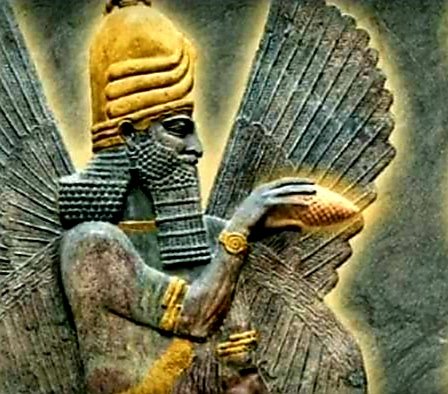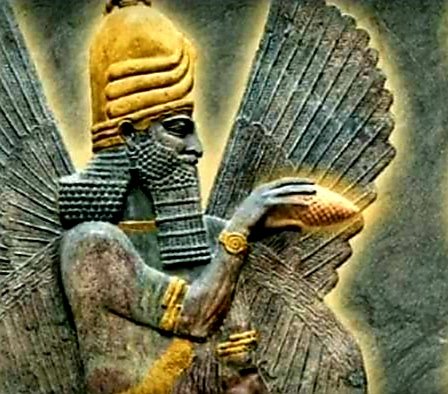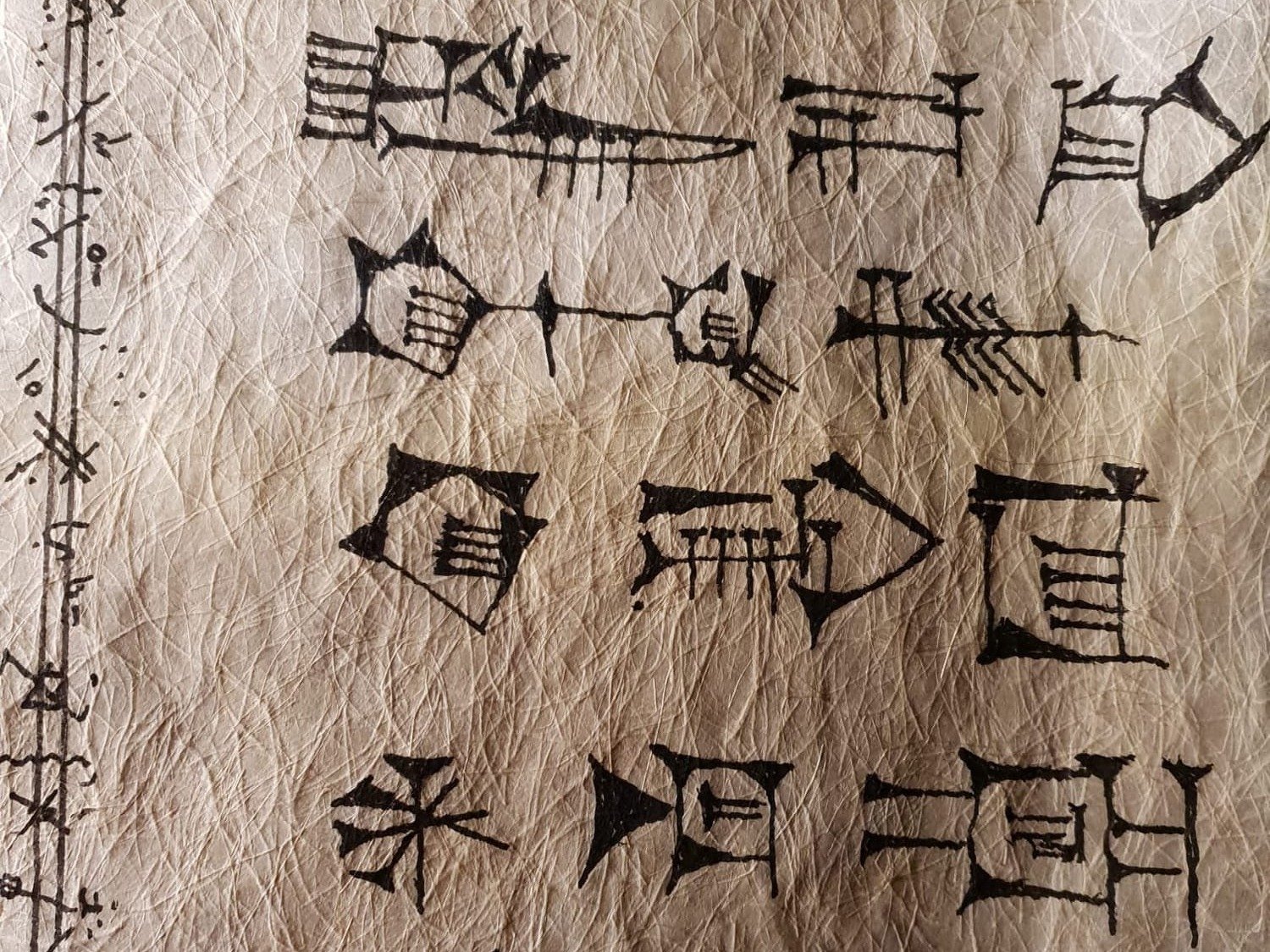THE GOLD OF THE SUMERIANS OR THE LEGEND OF THE ANNUNAKIS

ANUNNAKI MYTHOLOGIE ANTE DILUVIENNE
PALÉO-BABYLONIENNE. THE GOLD OF THE SUMERIANS OR THE LEGEND OF THE ANNUNAKIS
Mythologie des dieux Anunnakis
Texte paléo-babylonienne (premiers siècles du IIe millénaire av. J.-C.).
By Dr. JSDG DE GANAY
PRELIMINARU STUDY.
THE SUMERIAN CULTURE.
The Sumerians developed a complex polytheistic religion that influenced the religions of the Mesopotamian region that followed them, as well as the religions that later emerged around the world. This religion was based on a pantheon of gods and goddesses who were considered to have influence over all aspects of life, from nature and society to war and justice.
Pantheon of Sumerian gods and goddesses: The Sumerian pantheon included many gods and goddesses, each with a specific role and function in religion and daily life. Among the most important gods were Anu, the sky god; Enlil, the god of earth and wind; and Enki, the god of water and wisdom. The most important goddesses included Inanna, the goddess of love and war, and Ninhursag, the goddess of fertility and nature.
Sumerian myths and legends: The Sumerians had a rich tradition of myths and legends that explained the origin of the world, the creation of mankind, and the relationship between gods and humans. One of the most famous myths is the Epic of Gilgamesh, which tells the story of a king who seeks immortality.
Worship and rituals: The Sumerians had a complex system of worship and rituals to honor their gods. Temples were built throughout Mesopotamia to accommodate the gods, and offerings and sacrifices were common. Priests and priestesses were responsible for running temples and performing rituals.
Influence on later religions: The Sumerian religion had a considerable influence on the religions that followed in the Mesopotamian region, including the Babylonian religion and the Assyrian religion. These religions took over many aspects of Sumerian religion, such as the pantheon of gods and goddesses, myths and legends, and worship rituals. The Sumerian religion also influenced the religions that emerged later in the world including the Greek religion and the Roman religion.

BABYLONIAN AND ASSIRIAN INFLUANCE.
The Anunnaki were an integral part of Sumerian mythology, and influenced the beliefs of later cultures, such as Babylonian and Assyrian. However, there are significant differences in how these cultures interpreted the Anunnaki and their role in the world.
In Babylonian culture, the Anunnaki were considered superior gods who ruled over the other gods. They were often associated with specific planets and stars, and their influence on the world was considered to be directly related to the position of these celestial bodies. The Babylonians also believed that the Anunnaki were responsible for the creation of mankind, and that they had the power to decide the fate of individuals.
In Assyrian culture, the Anunnaki were also considered higher gods, but their role was often more limited. The Assyrians believed that the Anunnaki were responsible for the creation of the earth and the sky, but they were considered to be less involved in mortal affairs than in Babylonian culture. The Assyrians also believed that the Anunnaki were associated with particular deities, but these associations were often different from those of the Sumerians and Babylonians.
In both cultures, however, the Anunnaki were seen as powerful and often feared beings with the power to control the fates of mortals. Beliefs in their activities and influence have persisted for thousands of years.
THE SUMERIAN COUNTRY AND THE ANNANAKI EMPIRE IN THE LANDS OF BABYLON
The Babylonians and Assyrians were two peoples of ancient Mesopotamia, which today is located mainly in Iraq, but also partly in Syria and Turkey.
The Assyrians established their empire around the city of Assur, in present-day northern Iraq, around the start of the second millennium BC. Their empire spanned much of the Middle East, including present-day Iraq, Syria, Turkey, Iran, and even Egypt.
The Babylonians, for their part, established their empire around the city of Babylon, located in the south of present-day Iraq, around the beginning of the second millennium BC. Their empire also spanned much of the Middle East, including present-day Iraq, Syria, Jordan, Saudi Arabia, and Egypt.
Current Iraq was therefore an important territory for the Babylonians and Assyrians, who built many cities and monuments there, some of which are still visible today. Iraq is also considered the cradle of Mesopotamian civilization, which developed cuneiform writing, irrigated agriculture, monumental architecture, and other significant achievements.

There are many Babylonian and Assyrian archaeological sites where writings mentioning the Anunnaki have been found. Here is a non-exhaustive list of some of the most important sites:
1. Nippur: Located in the central region of Mesopotamia, this site was considered one of the most important religious centers of ancient Babylonia. Thousands of cuneiform tablets have been discovered at Nippur, many of which refer to the Anunnaki.
2. Nineveh: Located near the modern city of Mosul in Iraq, Nineveh was the capital of the Assyrian Empire. Many cuneiform texts have been discovered in Nineveh, some of which mention the Anunnaki.
3. Babylon: Located near the modern city of Hilla in Iraq, Babylon was one of the largest cities in ancient Mesopotamia. Thousands of cuneiform tablets have been discovered in Babylon, some of which refer to the Anunnaki.
4. Ur: Located in southern Iraq, Ur was an important city in Sumerian civilization. Cuneiform tablets have been discovered in Ur which refer to the Anunnaki.
5. Eridu: Located in southern Iraq, Eridu is considered one of the oldest cities in Mesopotamia. Cuneiform tablets have been discovered in Eridu which refer to the Anunnaki.
6. Uruk: Located in southern Iraq, Uruk was an important city in Sumerian civilization. Cuneiform tablets have been discovered in Uruk which refer to the Anunnaki.
GOLD MINING HISTORY.
Gold was extremely important in many ancient cultures, including the Sumerians. According to Sumerian mythology, the Anunnaki were a race of gods who created mankind and played an important role in human history.
The Anunnaki Aya was considered the goddess of dawn and fertility. She was often depicted with wings and horns, and was associated with renewal and creation. Aya was also associated with gold, which was considered a sacred metal in Sumerian culture.
Gold was of great value to the Sumerians, not only as a precious metal, but also because of its symbolic properties. It was associated with light, the sun and divinity. The Sumerians believed that gold was the metal of the gods, and that it had magical and healing properties.
The Sumerians began mining gold as early as the 4th millennium BC. Gold mines were located mainly in the Zagros Mountains in southwestern Iran, as well as in Turkey and the Caucasus. Gold was used to make jewelry, decorative items, statues and offerings for temples.
The Sumerians began to mine gold, officially as early as the 4th millennium BC, mainly in the Zagros Mountains, located in southwestern Iran, as well as in Turkey and the Caucasus. The gold mines were exploited in the open, but also in the alluvium, where this very fine gold was intended for votive art, and for export.
Gold was used to make jewelry, decorative items, statues, and offerings for temples. The Sumerians believed that gold was the metal of the gods and had magical and healing properties. They also used gold in religious rituals, as offerings to the gods and to decorate temples, but this huge amount of gold has curiously never been found, as purely volatilized.
In Sumerian mythology, the Anunnaki were considered gods who were responsible for creating mankind and teaching arts and sciences to humans. The Anunnaki Enki was considered the god of mines and mining. He was often depicted with a vase which symbolized the extraction of elements like gold from the earth.
In the Sumerian Flood legend, Enki warns the story's hero, Ziusudra, of impending doom and advises him to build an ark to save his family and the animals. Enki also helps Ziusudra survive the flood by providing him with instructions to find drinking water and food. In this story, Enki is considered the savior of mankind.
It is possible that the Sumerians associated gold with Enki due to his association with mining. The Sumerians believed that the gods were responsible for creating the minerals in the earth, and the extraction of these minerals was considered a sacred act that allowed humans to access the riches of the gods.

OF GOLD AND MYTOLOGY.
We all know that the term Anunnaki refers to the most important deities of the Sumerian pantheon, the praiseworthy coast of the texts ( verses ) and still here and still debated, in a number of more or less academic versions.
However, all agree in saying and in believing that the modernity of the literary senses, questions us, more than ever, about the paleo-diluvian origins of the very ancient and extinct history of a civilization and a culture, which from the first readings left us amazed.
These original texts which are at the origin of everything and many mythologies, and which even seem in the Zoroaster, Greek, and Babylonian cultures, to have influenced the deep history of all our origins, remain mysterious in their modernity, their mathematical meanings and ethnographic.
In the extinct Semitic language (Akkadian), whose root is probably Sumerian and which can be found from the third century BC, the extent of the vast corpus of content related to Semitic and the doctrine of the ancient gods is considerable.
We find there the oldest form of the mythology of the deluge and the history of man already destroying his world, and the patience of the gods, who came to earth to exploit the gold of the earth and its resources and create man to accomplish his task in his place.
It is strongly and obviously interesting to make the recurring link with our enthusiastic and modern era, where man with or without gods will bury his own destiny, unable to resist the rustle of his uneducated and destructive modernity.
If we notice the extinction of civilizations in the long history of our humanity, but very short on a modern geological scale, it is undoubtedly that the cycles of development and extinctions of this one repeated themselves with more or less intensity.
In Babylonian history Man would have been created in the image of the gods without being immortal, with the intention of serving them, in particular to accomplish their tasks in their place.
Among the texts found in the study of mythology (Anunaki) the story of the flood is a major study in the pre-guard of these ancient verses, with in particular the mythology of Atrahasis.
Atrahasis is a character from Mesopotamian mythology who would have survived the deluge, caused by the gods, to punish men, he would then have obtained immortality from the gods. His legend is told in the Epic of Atrahasis (Atrahasis)
The Epic of Atrahasis or Poem of the Supersage
Atrahasis (from Akkadian "scepter of ingenuity.
(myth of "Enki and Ninhursag")
Second part of the text composed of approximately 1200 verses, and which will later give rise to the mythology of Noah...
"Men carry out their task to perfection, but they are however very troublesome for the gods now all idle, who can no longer find rest in the din that men make, especially since the latter never cease to multiply and increase in number all the time.”
"To solve this new problem, Enlil, the supreme god, sent first terrible epidemics, then famine to decimate his servants. But Ea, god of fresh waters, protector of humans - his work - always foiled his plans by the intermediary of his protege Atrahasis, the "very wise", a man who warned his people of every danger. Enlil, increasingly exasperated, decided to put an end to humans once and for all by unleashing the Deluge,"
THE ANUNNAKI AND THE STARS.
The Mesopotamian texts on the stars are numerous, for some they refer to Nibiru, they include several cuneiform tablets, in particular the famous "Mesopotamian Chronicles", which are historical registers detailing the notable events of ancient Mesopotamia. The name Nibiru appears in these chronicles as being associated with the Anunnaki gods and their mythology.
The Babylonian epic poem Enuma Elish is also an important text that mentions Nibiru. It describes the creation of the universe by the god Marduk, who is said to have created the world from the body of an evil dragon named Tiamat. According to the poem, Nibiru is the planet that marks the beginning and end of the year of the universe, and is associated with the god Marduk.
In Mesopotamian texts, Nibiru is often described as having a highly elliptical orbit which would cause it to appear in the sky approximately every 3,600 years. Some researchers have interpreted this as a reference to a possible unknown planet in the solar system, which would partly explain the absence of the star chart for this planet.

THE LEGEND OF THE STARGATE.
The principle of the stargate is, in theory, executable in reality. esque the Anunnaki would have taken advantage of a technology left in paleo-antediluvian times by another civilization, to transport the gold which prevented the exploitation of men, ..?!
what is certain is that far from this very daring thesis, the reality is not very far from science fiction.
It is a scientific phenomenon already predicted by Einstein, and does not conflict with string theory. It was also decried for a long time.
A real door would be based on the distortion of space-time to allow travel throughout the universe, notably via a Reissner-Nordström wormhole, but the gravity necessary to form these wormholes would destroy any intergalactic traveler.
In Stargate, this problem is circumvented by breaking down any object entering the gate to the subatomic level before it passes through the wormhole and rebuilding it upon arrival. It is in fact the principle of teleportation demonstrated 10 years ago by a team of American researchers, who succeeded in teleporting a neutron from one tube to another...
All of this research will be difficult if not impossible to complete without a unified theory of physics. In theory, even if we know today that to demonstrate a process is only in a complication to be implemented, more than to conceive this one.
So what are the historical physical discoveries that led science to the beginnings of fundamental research in this very random and very specific little corner of the field.
Several archaeological sites have delivered at different times sometimes impressive artefacts which have duly provoked certain questions and interrogations.
Among these artifacts, several other stargates have been found, including a gate in Iraq in August 1949 at Nasiriyah about 370 km southeast of Baghdad. In antiquity, Nasiriyah was Ur, and the great temple of Ziggurat was located there.
MAJOR INSCRIPTIONS FROM THE MESOPOTAMIAN TEMPLE OF THE "GREAT ZIGGURAT" FROM THE VILKE OF Ur IN IRAQ.
The gods and goddesses worshiped in the Temple of the Great Ziggurat of Ur included the moon god Nanna (or Sin), the goddess of love and war Inanna (or Ishtar), the sun god Shamash, the water god Enki (or Ea), and the mother goddess Ninhursag. The rulers of Ur were often associated with these gods and goddesses, and temple inscriptions often mentioned them in connection with them.
Here is an example of an inscription discovered in the temple of the great ziggurat of Ur:
"Shu-Sin, king of Ur, king of Isin, king of Larsa, son of Ur-Nammu, king of Ur, built this temple for Nanna his lord, that Nanna would grant him a long term of life, great power and long kingship. May Nanna, the lord of the moon, grant justice and righteousness to his servant Shu-Sin, the king of Ur."
This inscription shows how the kings of Ur were associated with Nanna, the moon lord, and how they sought to gain his favor by building temples in his honor. The text ends with a prayer asking Nanna to protect the king and grant him long life and kingship.
Another famous inscription discovered in the temple of the great ziggurat of Ur is the "Stele of Ur-Nammu", which presents the code of laws of Ur-Nammu, the founder of the third dynasty of Ur. This code of laws is considered one of the oldest in the world, predating the famous code of Hammurabi by several centuries.
GOLD, THE ANUNAKI. AND THE SUMERIAN GODS
For the Sumerians gold and god are one The Earth is linked to the gods of the sky, the sun, the fire of matter, consumes all energies, and without gold, matter becomes inert...
It is to the God Ea or Aya, divinity of the "Earth below, of techniques and science, he is the guardian of magic, of multipolar knowledge, he is the immense Sumerian divinity of alchemists and scholars, and the keeper of the gold of the earth...
The Anunaki consider gold as the center of the sky, that of knowledge, cosmic energy and universal fire....
In the Mesopotamian cosmogony, everything that is found here below, and in man, has its celestial equivalent.
Thus the Sumerian goddess Inanna, who became Ishtar in Akkadian, venerated in Ur and Assur, corresponded to the planet Venus, to war and to love. The god Enki (Ea) was associated with the city of Eridu, the world of underground waters (Abzu), intelligence and knowledge; Enki is the father of Marduk, god of Babylon, associated with Jupiter and victory over chaos.
In the Sumerian Epic of Creation, which recounts the origins of the world, Tiamat, Abzu's lover, is defeated by Marduk, and her body becomes Earth and Heaven. It's "Ipazuzu" or "Logos"
The ANUNAKI speak of Mul-ge ("the black star") where the tears of the sun (gold) are born...
Just like light and energy, gold comes from the stars, so consciousness and the nativity of spirit join matter, thought and spirit.
Dr. JSDG DE GANAY.
Geological Engineer .
Mineralogist / Micro'-mineralogy.
Metallogeny of rare elements.
Metalogeny of radionuclides.
metallogenesis of ancient civilizations.
Researcher in Major Risks.


